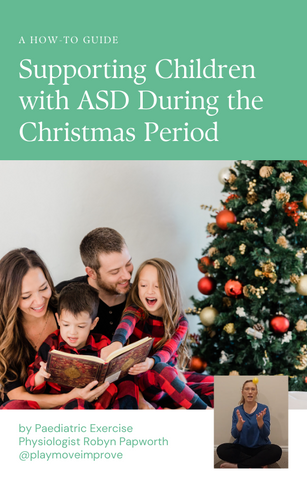The holiday season is upon us, and for families with children on the Autism Spectrum (ASD), it can be a time filled with unique challenges. The bright lights, bustling crowds, strong smelling candles and foods, and social gatherings that define Christmas can be overwhelming for children with ASD, as well as their parents.
But fear not! We're here to help you navigate this festive season with confidence, joy, and a touch of magic.




Your Path to a Harmonious Christmas Begins Here
At Play Move Improve, we understand the struggles that come with making the holiday season enjoyable and sensory-friendly for children with ASD. That's why we're excited to introduce you to two valuable resources that will transform your Christmas this year.
Your Free ASD Christmas Strategies Handout
Before we dive into the details of our empowering coaching program, let's start with a gift for you – our Free ASD Christmas Strategies Handout. This resource is designed to provide you with practical tips and insights to create a sensory-friendly and harmonious Christmas environment for your child.
In this handout, you'll discover:
- Sensory-Friendly Decorating Tips: Learn how to deck the halls in a way that won't overwhelm your child's senses.
- Stress-Free Holiday Shopping: Find strategies for making your trips to the shops smoother and less daunting.
- Communication and Social Interaction Techniques: Get expert guidance on how to navigate social gatherings and maintain your child's comfort.
This handout is the first step toward ensuring your child can experience the magic of Christmas without sensory overload and stress.
Download it for free [here] and let the transformation begin.
Here are a few strategies that families can try this Christmas to reduce their child's stress and promote connection:
-
Create a Sensory-Friendly Space: Many children with ASD, ADHD, and/or from a traumatic background are sensitive to sensory stimuli as their amygdala and RAS areas of the brain may not be functionally appropriately. To support children's sensory challenges, designate a quiet and calming space in your home where your child can retreat when they feel overwhelmed by the flashing lights and smells of the Christmas decor. This space could be equipped with sensory-friendly items like soft blankets, noise-cancelling headphones, and calming fidget toys. Encourage your child to use this space as needed and let them know it's a safe haven where they can decompress when needed. Try to avoid electronic devices in this zone so that their sensory systems can have a break from the excessive sensory input (sights, sound) that comes from electronic devices too.
-
Prepare a Visual Schedule: Create a visual schedule or calendar for the holiday season. Use pictures or symbols to represent the different activities and events planned for each day. This helps your child understand and anticipate what's coming, reducing anxiety associated with surprises or changes in routine. Review the schedule together each morning to provide a sense of structure and predictability. Make sure that your routine includes sensory, movement, and mindfulness breaks, for both of you.
-
Practice Clear Communication: Encourage open and clear communication within your family. Use simple and direct language to explain the day's activities and expectations. If there are any changes in plans, be sure to communicate these in advance. Listen actively to your child's concerns and preferences, and involve them in decision-making when possible. Effective communication fosters understanding and reduces frustration.
- Visual Social Story for Holiday Gatherings: Create a visual social story that explains what will happen during holiday gatherings and family events. Use pictures or symbols to outline the sequence of events, such as arriving at the event, greeting relatives, and participating in activities. Include your child in the process by letting them add or select images. Review the social story with your child before each event, helping them understand what to expect and how to behave. This visual support can reduce anxiety and improve your child's ability to navigate social interactions.
- Sensory-Friendly Gift Wrapping: Embrace the art of sensory-friendly gift wrapping. Instead of using traditional noisy, crinkling wrapping paper, consider using fabric bags, which can be reused and have a pleasing texture and quieter sound. Attach ribbons or tags that provide sensory feedback if needed. Involve your child in this creative process, allowing them to participate in wrapping or decorating gifts. It's an excellent way to bond and make the holiday preparation process enjoyable.
I would like to share with you one strategy that we used last year to support a young boy who we'll name Michael, with this sensory adversion to the smell of ham.
Sarah's family loves the tradition of serving a delicious Christmas ham, but her 12-year-old son, Michael, who has sensory sensitivities, becomes nauseated by the strong smell of it. Michael has a heightened sense of smell, and the aroma of the ham makes him feel uncomfortable, especially during the Christmas meal.
To address Michael's sensitivity to the smell of Christmas ham, Sarah created a designated "Scent-Neutral Zone" at their holiday dinner table. In this area, she set up Michael's favourite dishes and sides, which didn't include ham. She also placed a small, battery-operated air purifier nearby to help minimise food odours for Michael.
Whenever Michael felt overwhelmed by the ham's smell, he knew he could retreat to his special zone for a while. This allowed him to enjoy his meal without feeling nauseous and overwhelmed. The family respected Michael's need for a scent-neutral space, and it has become an accepted part of their holiday tradition.
This strategy helped Michael participate in the Christmas meal with less stress and more comfort, contributing to a more enjoyable holiday experience for everyone.
Ready to Transform Your Christmas?
Don't let the challenges of Christmas overwhelm your family this year. Download our Free ASD Christmas Strategies Handout
Remember, you're not alone on this journey. We're here to support you every step of the way.


